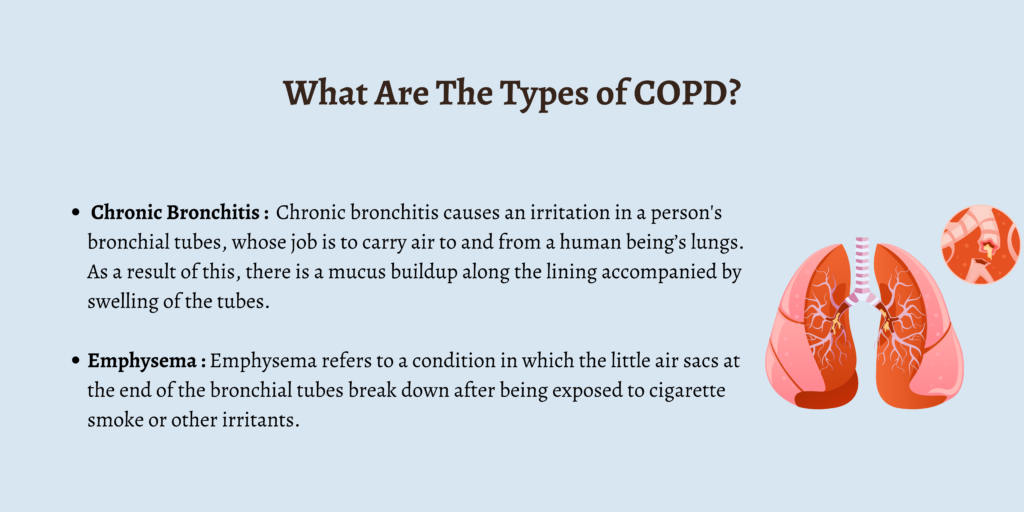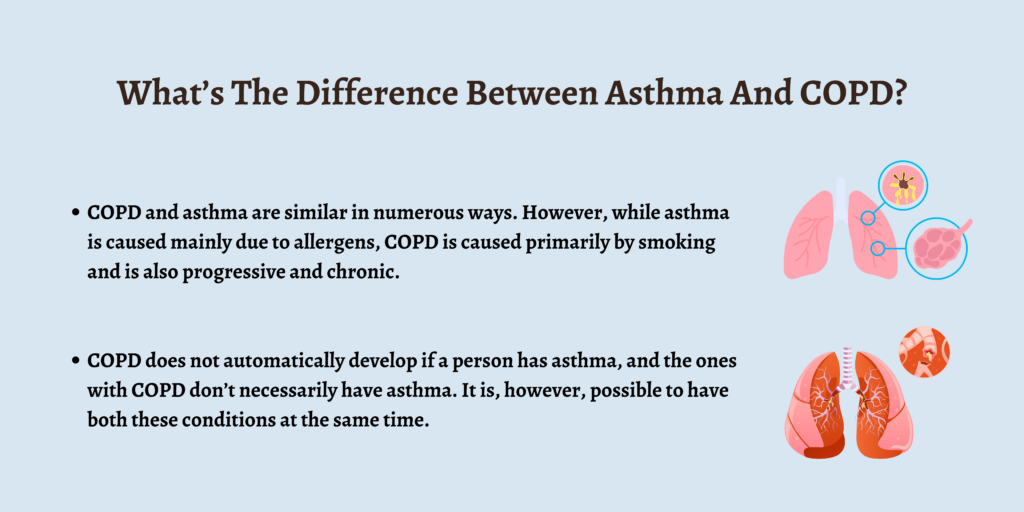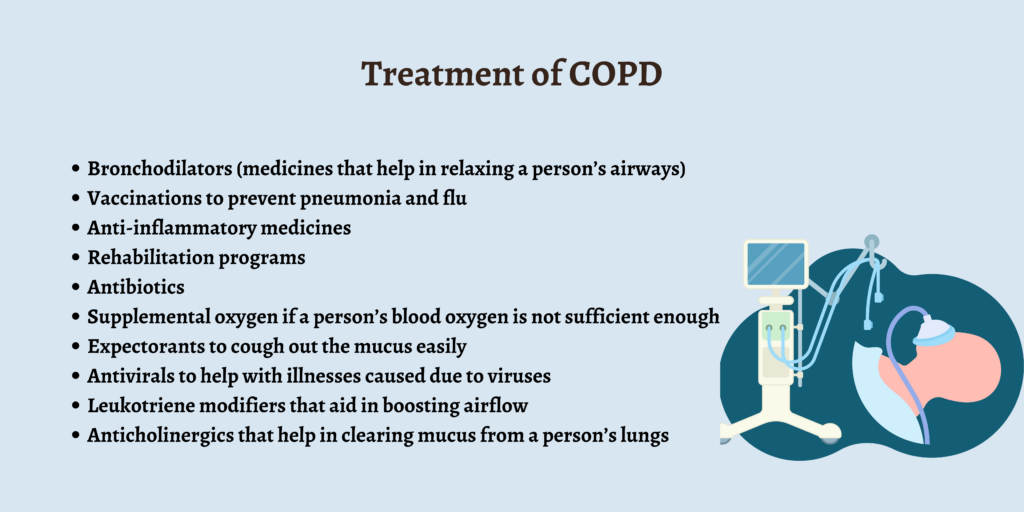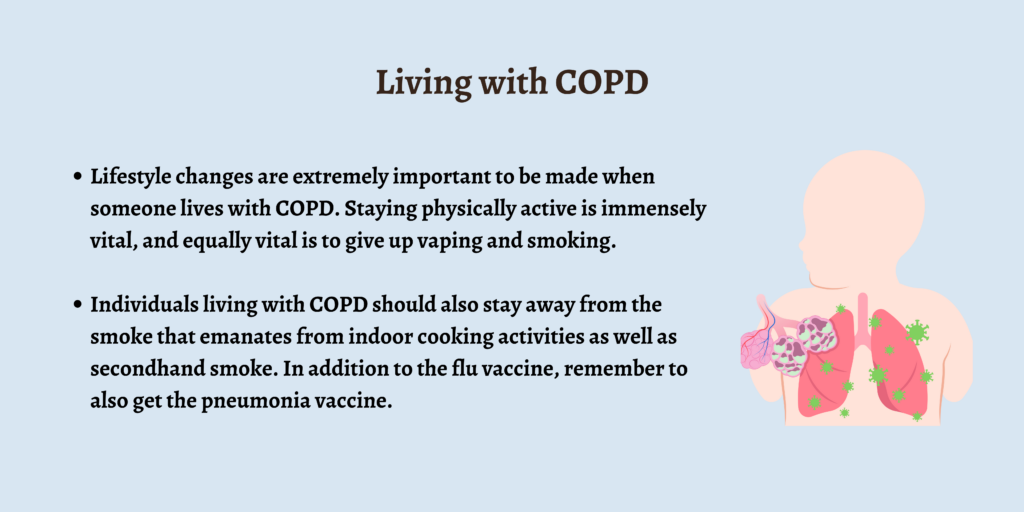What is COPD?
Chronic obstructive pulmonary disease, or COPD, is a common chronic inflammatory lung disease or a group of progressive lung diseases. It leads to breathing issues and restricted airflow.
Individuals who suffer from COPD can witness their lungs getting clogged with phlegm, thereby damaging them. It’s mostly caused due to air pollution and smoking, and the ones who suffer from this disease are also more vulnerable to other health issues.
The Causes of COPD Include
- Having asthma during childhood
- Exposure to tobacco smoke or secondhand smoke
- Genetic condition
- Indoor air pollution
- Occasionally being exposed to chemicals, fumes, or dust
The progress of COPD happens gradually, therefore making it more difficult for the individual to breathe as time goes by. In this article, we will be discussing the symptoms of COPD, the different types, the diagnosis and treatment involved, and much more.
What Are The Symptoms of COPD?
The symptoms related to COPD usually occur after a person’s lungs have been significantly damaged. The signs and symptoms of COPD are as follows:
- Lack of energy
- Tightness in the chest
- Unintentional weight loss
- Shortness of breath
- Wheezing
- Frequent respiratory infections
- Swollen legs, feet, or ankles
- Chronic cough that could produce mucus
What Are The Types of COPD?
The types of COPD are as listed below:
Chronic Bronchitis
Chronic bronchitis causes an irritation in a person’s bronchial tubes, whose job is to carry air to and from a human being’s lungs. As a result of this, there is a mucus buildup along the lining accompanied by swelling of the tubes.
The opening of the tube then gets narrow due to the mucus buildup, which makes it difficult for the air to get in and out of the individual’s lungs. This usually leads to mucus production and the person coughing on a daily basis.
Emphysema
Emphysema refers to a condition in which the little air sacs at the end of the bronchial tubes break down after being exposed to cigarette smoke or other irritants.
Since the air sacs are responsible for carrying out carbon dioxide and bringing in oxygen into the blood, this condition leads to difficulty in being able to breathe properly.
What’s The Difference Between Asthma And COPD?
COPD and asthma are similar in numerous ways. However, while asthma is caused mainly due to allergens, COPD is caused primarily by smoking and is also progressive and chronic.
COPD does not automatically develop if a person has asthma, and the ones with COPD don’t necessarily have asthma. It is, however, possible to have both these conditions at the same time.
How Common is COPD?
As per reports, close to 15 million individuals in the United States of America were diagnosed with COPD, and 12 million were yet to be diagnosed.
How is COPD Diagnosed?
When you go to your doctor to get your condition diagnosed, they will firstly ask you about your medical history. The questions they could ask include:
- Are you a smoker?
- Do you cough up phlegm?
- Have you been exposed to air pollutants on a long-term basis?
- Do you experience shortness of breath?
- Do any of your family members have COPD?
- Have you been wheezing or coughing for a while now?
The doctor will then proceed to give you a physical exam, which can include:
- Examination of your throat and nose.
- Listening to your heart and lungs.
- Checking if your ankles and feet are swollen.
- Checking your pulse and blood pressure.
Lastly, they will conduct a few tests from the ones listed below:
- Chest X-ray
- Electrocardiogram
- Pulse oximetry
- Exercise testing
- Chest CT scan
- Arterial blood gases
Treatment of COPD
COPD can be treated through one of the following ways:
- Bronchodilators (medicines that help in relaxing a person’s airways)
- Vaccinations to prevent pneumonia and flu
- Anti-inflammatory medicines
- Rehabilitation programs
- Antibiotics
- Supplemental oxygen if a person’s blood oxygen is not sufficient enough
- Expectorants to cough out the mucus easily
- Antivirals to help with illnesses caused due to viruses
- Leukotriene modifiers that aid in boosting airflow
- Anticholinergics that help in clearing mucus from a person’s lungs
How Can I Manage COPD at Home?
Here are the ways in which you can manage COPD at home:
- Give up smoking.
- Have a well-balanced diet so as to maintain a healthy weight.
- Try to avoid an environment filled with fumes, smoke, chemicals, or dust.
- Diligently consume the medicines prescribed by your doctor.
- Take an annual flu shot.
- Look into a pulmonary rehabilitation program by discussing it with your healthcare provider.
Living with COPD
Lifestyle changes are extremely important to be made when someone lives with COPD. Staying physically active is immensely vital, and equally vital is to give up vaping and smoking.
Individuals living with COPD should also stay away from the smoke that emanates from indoor cooking activities as well as secondhand smoke. In addition to the flu vaccine, remember to also get the pneumonia vaccine.
How to Prevent COPD
There are ways in which you can prevent COPD or slow down its progression. Listed below are the ways in which COPD can be prevented:
- Wash your hands before eating, taking medicines, and cooking.
- Wash your hands thoroughly after using the bathroom, coughing, and being around someone who is suffering from a cold.
- Keep your home clean and get rid of any dust around.
- Avoid any sources of air pollution, such as tobacco smoke, car exhaust fumes, and pollen.
- Stay away from large crowds during peak flu season.
- Clean any breathing equipment efficiently.
- Don’t share your medical equipment with other people.
- Follow a healthy diet.
- Keep yourself hydrated and consume plenty of fluids.
- Manage your stress levels.
- Get enough rest and sleep.
- Get the flu shot every year and also look into the pneumonia vaccine.
FAQs
1. What are the symptoms of COPD?
The symptoms of COPD are feeling tired, chronic cough, wheezing, chest tightness, and shortness of breath.
2. What are the causes of COPD?
The causes of COPD include exposure to tobacco, having asthma as a child, and indoor air pollution.
3. How to prevent COPD?
COPD can be prevented by washing your hands thoroughly before eating and after using the bathroom, keeping your home clean, not sharing your medical equipment, and avoiding sources of air pollution.
4. How to manage COPD at home?
The way to manage COPD at home is by maintaining a healthy weight, staying away from secondhand smoke, and taking your flu vaccine annually.
5. How can a person live with COPD?
A person can live with COPD by staying updated with the necessary vaccinations and giving up vaping or smoking.
Conclusion
The rate at which COPD progresses differs from one person to another. Although lung damage can’t be reversed, early treatment and lifestyle changes can help in dealing with the symptoms.
Life expectancy for a person with COPD depends on how they manage their treatment, their overall health, and how soon they find a healthcare provider to take a look at the situation.
If you feel like your COPD symptoms are either not improving or getting worse, call your doctor immediately, especially if you witness fever or signs of an infection. Calling the emergency medical services and seeking immediate medical care is imperative in such cases.







